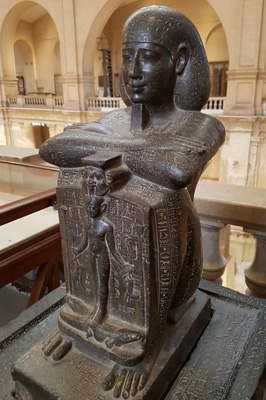
- Tab 1
October 2021 Meeting
An introduction by Trevor Cowie
As our guest speaker this month, we look forward to welcoming Dr Joanne Rowland (University of Edinburgh) who will be giving a presentation on ‘Djedhor and the cult of Horus Khenty-Khety: contextualising a Ptolemaic animal necropolis in the southern Nile Delta’. Joanne’s talk will be delivered via Zoom on Thursday 21 October, commencing at 7.30pm.

From 2007-2020 excavations have been carried out by the EES Delta-Survey mission in a falcon necropolis at the archaeological area at Quesna in the southern central Nile Delta. This necropolis, first located by the Supreme Council of Antiquities, has yielded new evidence to link it to nearby Tell Atrib (ancient Athribis). It was most probably founded by the priest, Djed Hor Pashed, known from inscriptions to be connected with Athribis. Extended in size over its period of its use (Late Period-Ptolemaic Period), the necropolis contains many thousands of votive offerings in association with the local deity of Athribis, Horus Khenty-Khety. The talk will review the current state of knowledge of this necropolis, discuss how its use over time may have changed, and present preliminary the results of analysis of the whole team into the spatial distribution of finds and bird and animal remains within the necropolis.
 After gaining her PhD from University College London in 2004, Joanne worked on the Egyptian Chronology project at the University of Oxford and as a Scientific Collaborator on the Elkab project at the Royal Museums of Art and History in Brussels before going on to take up a Junior-Prof. position in the Egyptology Dept of the Free University of Berlin. In 2016 she moved to Edinburgh where she is now a Senior Lecturer. She has been working in the Delta since 1998 on projects ranging from prehistory until, at Quesna, the Ptolemaic-Roman period. She has worked with colleagues from various universities and institutions including the German Archaeological Institute and The Egypt Exploration Society (EES) whom the work at Quesna runs under. Her research speciality is Egyptian prehistory and the early historic period, and in this respect she recently started directing a new programme of work at the Neolithic site of Merimde Beni Salama. She is also the deputy director of a project at Naqada, a well-known Predynastic site in southern Egypt.
After gaining her PhD from University College London in 2004, Joanne worked on the Egyptian Chronology project at the University of Oxford and as a Scientific Collaborator on the Elkab project at the Royal Museums of Art and History in Brussels before going on to take up a Junior-Prof. position in the Egyptology Dept of the Free University of Berlin. In 2016 she moved to Edinburgh where she is now a Senior Lecturer. She has been working in the Delta since 1998 on projects ranging from prehistory until, at Quesna, the Ptolemaic-Roman period. She has worked with colleagues from various universities and institutions including the German Archaeological Institute and The Egypt Exploration Society (EES) whom the work at Quesna runs under. Her research speciality is Egyptian prehistory and the early historic period, and in this respect she recently started directing a new programme of work at the Neolithic site of Merimde Beni Salama. She is also the deputy director of a project at Naqada, a well-known Predynastic site in southern Egypt.
We are always delighted to welcome new members: for details of current subscription rates, check out our Membership page. Please do get in touch if you have any queries.
Illustrations
1. Excavations at the large cemetery or necropolis (literally ‘city of the dead’) at Quesna have revealed evidence for huge numbers of animal offerings, particularly falcons, as part of the religious rites (Photo: J. Rowland).
2. Black basalt statue of Djedhor in The Egyptian Museum, Cairo (Photo: W. Webb).